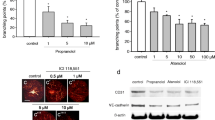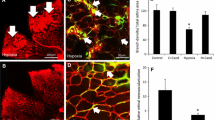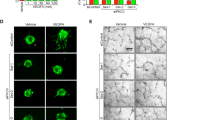Abstract
Beta-adrenergic receptors (β-ARs) play a role in angiogenic processes that characterize neovascularization-associated retinal diseases, but the role of β3-ARs has not been disclosed yet. We used ex vivo retinal explants to investigate the role of β3-ARs in regulating vascular endothelial growth factor (VEGF) release associated with hypoxia. Whether nitric oxide (NO) mediates β3-AR regulation of VEGF release was also investigated. β3-AR activation was obtained using BRL 37344, whereas SR59230A, L-748,337, or specific siRNAs were used to block β3-ARs. Pharmacological approaches were used to interfere with the NO pathway. Western blot was used to determine β-AR levels. Enzyme-linked immunosorbent assay was used to measure VEGF release. NO production was assessed by a colorimetric assay. We found that hypoxia upregulates β3-ARs. In addition, we observed that β3-AR activation with BRL 37344 increases VEGF release in response to hypoxia. Either β3-AR blocker or β3-AR silencing downregulates drastically hypoxic levels of VEGF. With experiments using NO synthase (NOS) blockade with L-NAME, NOS activation with fluvastatin or NO supplementation with SNAP, we demonstrated that β3-ARs and VEGF are functionally coupled via the NO pathway. In summary, the data presented here support the assumption that β3-ARs are involved in the regulation of angiogenic responses to hypoxia through the NO signalling, a key pathway in hypoxic/ischemic diseases. Although extrapolation of these data to the human situation is difficult, these findings may help to explore the possible role of β3-ARs in vascularization-associated disorders.






Similar content being viewed by others
References
Aragón JP, Condit ME, Bhushan S, Predmore BL, Patel SS, Grinsfelder DB, Gundewar S, Jha S, Calvert JW, Barouch LA, Lavu M, Wright HM, Lefer DJ (2011) Beta3-adrenoreceptor stimulation ameliorates myocardial ischemia-reperfusion injury via endothelial nitric oxide synthase and neuronal nitric oxide synthase activation. J Am Coll Cardiol 58:2683–2691
Arden GB, Sivaprasad S (2011) Hypoxia and oxidative stress in the causation of diabetic retinopathy. Curr Diabetes Rev 7:291–304
Ballester C, Sarriá B, García-Granero E, Mata M, Milara J, Morcillo EJ, Lledó S, Cortijo J (2010) Relaxation by beta 3-adrenoceptor agonists of the isolated human internal anal sphincter. Life Sci 86:358–364
Breit A, Lagacé M, Bouvier M (2004) Hetero-oligomerization between beta2- and beta3-adrenergic receptors generates a beta-adrenergic signaling unit with distinct functional properties. J Biol Chem 279:28756–28765
Bryan NS, Bian K, Murad F (2009) Discovery of the nitric oxide signaling pathway and targets for drug development. Front Biosci 14:1–18
Candelore MR, Deng L, Tota L, Guan XM, Amend A, Liu Y, Newbold R, Cascieri MA, Weber AE (1999) Potent and selective human beta(3)-adrenergic receptor antagonists. J Pharmacol Exp Ther 290:649–655
Carpéné C, Galitzky J, Fontana E, Atgié C, Lafontan M, Berlan M (1999) Selective activation of beta3-adrenoceptors by octopamine: comparative studies in mammalian fat cells. Naunyn Schmiedebergs Arch Pharmacol 359:310–321
Cawley SM, Kolodziej S, Ichinose F, Brouckaert P, Buys ES, Bloch KD (2011) sGC{alpha}1 mediates the negative inotropic effects of NO in cardiac myocytes independent of changes in calcium handling. Am J Physiol Heart Circ Physiol 301:H157–H163
Chen J, Smith LE (2007) Retinopathy of prematurity. Angiogenesis 10:133–140
Chen H, Ikeda U, Shimpo M, Ikeda M, Minota S, Shimada K (2000) Fluvastatin upregulates inducible nitric oxide synthase expression in cytokine-stimulated vascular smooth muscle cells. Hypertension 36:923–928
Chen J, Joyal JS, Hatton CJ, Juan AM, Pei DT, Hurst CG, Xu D, Stahl A, Hellstrom A, Smith LE (2012) Propranolol inhibition of β-adrenergic receptor does not suppress pathologic neovascularization in oxygen-induced retinopathy. Invest Ophthalmol Vis Sci 53:2968–2977
Curatola AM, Moscatelli D, Norris A, Hendricks-Munoz K (2005) Retinal blood vessels develop in response to local VEGF-A signals in the absence of blood flow. Exp Eye Res 81:147–158
Dal Monte M, Ristori C, Cammalleri M, Bagnoli P (2009) Effects of somatostatin analogues on retinal angiogenesis in a mouse model of oxygen-induced retinopathy: involvement of the somatostatin receptor subtype 2. Invest Ophthalmol Vis Sci 50:3596–3606
Dal Monte M, Ristori C, Videau C, Loudes C, Martini D, Casini G, Epelbaum J, Bagnoli P (2010) Expression, localization, and functional coupling of the somatostatin receptor subtype 2 in a mouse model of oxygen-induced retinopathy. Invest Ophthalmol Vis Sci 51:1848–1856
Dal Monte M, Martini D, Latina V, Pavan B, Filippi L, Bagnoli P (2012) Beta-adrenoreceptor agonism influences retinal responses to hypoxia in a model of retinopathy of prematurity. Invest Ophthalmol Vis Sci 53:2181–2192
DeNiro M, Alsmadi O, Al-Mohanna F (2009) Modulating the hypoxia-inducible factor signaling pathway as a therapeutic modality to regulate retinal angiogenesis. Exp Eye Res 89:700–717
Dessy C, Balligand JL (2010) Beta3-adrenergic receptors in cardiac and vascular tissues emerging concepts and therapeutic perspectives. Adv Pharmacol 59:1351–1363
Dessy C, Moniotte S, Ghisdal P, Havaux X, Noirhomme P, Balligand JL (2004) Endothelial beta3-adrenoceptors mediate vasorelaxation of human coronary microarteries through nitric oxide and endothelium-dependent hyperpolarization. Circulation 110:948–954
Dulak J, Józkowicz A (2003) Regulation of vascular endothelial growth factor synthesis by nitric oxide: facts and controversies. Antioxid Redox Signal 5:123–132
Fredriksson JM, Lindquist JM, Bronnikov GE, Nedergaard J (2000) Norepinephrine induces vascular endothelial growth factor gene expression in brown adipocytes through a beta-adrenoreceptor/cAMP/protein kinase A pathway involving Src but independently of Erk1/2. J Biol Chem 275:13802–13811
He T, Xing YQ, Zhao XH, Ai M (2007) Interaction between iNOS and COX-2 in hypoxia-induced retinal neovascularization in mice. Arch Med Res 38:807–815
Hodis J, Vaclavíková R, Farghali H (2011) Beta-3 agonist-induced lipolysis and nitric oxide production: relationship to PPARgamma agonist/antagonist and AMP kinase modulation. Gen Physiol Biophys 30:90–99
Ignarro LJ, Sisodia M, Trinh K, Bedrood S, Wu G, Wei LH, Buga GM (2002) Nebivolol inhibits vascular smooth muscle cell proliferation by mechanisms involving nitric oxide but not cyclic GMP. Nitric Oxide 7:83–90
Joussen AM, Poulaki V, Qin W, Kirchhof B, Mitsiades N, Wiegand SJ, Rudge J, Yancopoulos GD, Adamis AP (2002) Retinal vascular endothelial growth factor induces intercellular adhesion molecule-1 and endothelial nitric oxide synthase expression and initiates early diabetic retinal leukocyte adhesion in vivo. Am J Pathol 160:501–509
Kaempf S, Walter P, Salz AK, Thumann G (2008) Novel organotypic culture model of adult mammalian neurosensory retina in co-culture with retinal pigment epithelium. J Neurosci Methods 173:47–58
Kanie S, Otsuka A, Yoshikawa S, Morimoto T, Hareyama N, Okazaki S, Kobayashi R, Hasebe K, Nakao K, Hayashi R, Mochizuki H, Matsumoto R, Ozono S (2012) Pharmacological effect of TRK-380, a novel selective human β3-adrenoceptor agonist, on mammalian detrusor strips. Urology 79:744, e1-7
Kaur C, Foulds WS, Ling EA (2008) Blood-retinal barrier in hypoxic ischaemic conditions: basic concepts, clinical features and management. Prog Retin Eye Res 27:622–647
Kaur C, Sivakumar V, Foulds WS, Luu CD, Ling EA (2009) Cellular and vascular changes in the retina of neonatal rats after an acute exposure to hypoxia. Invest Ophthalmol Vis Sci 50:5364–5374
Kubota Y, Nakahara T, Yunoki M, Mitani A, Maruko T, Sakamoto K, Ishii K (2002) Inhibitory mechanism of BRL37344 on muscarinic receptor-mediated contractions of the rat urinary bladder smooth muscle. Naunyn Schmiedebergs Arch Pharmacol 366:198–203
Leblais V, Pourageaud F, Ivorra MD, Marthan R, Muller B (2005) Comparison of the alpha-adrenoceptor-mediated effects of beta3-adrenoceptor ligands in rat pulmonary artery. Naunyn Schmiedebergs Arch Pharmacol 371:535–539
Li SY, Fu ZJ, Lo ACY (2012) Hypoxia-induced oxidative stress in ischemic retinopathy. Oxid Med Cell Longev 2012:426769
Livak KJ, Schmittgen TD (2001) Analysis of relative gene expression data using real-time quantitative PCR and the 2(−delta delta C(T)) method. Methods 25:402–408
Martini D, Dal Monte M, Ristori C, Cupisti E, Mei S, Fiorini P, Filippi L, Bagnoli P (2011) Antiangiogenic effects of β2 -adrenergic receptor blockade in a mouse model of oxygen-induced retinopathy. J Neurochem 119:1317–1329
Massion PB, Dessy C, Desjardins F, Pelat M, Havaux X, Belge C, Moulin P, Guiot Y, Feron O, Janssens S, Balligand JL (2004) Cardiomyocyte-restricted overexpression of endothelial nitric oxide synthase (NOS3) attenuates beta-adrenergic stimulation and reinforces vagal inhibition of cardiac contraction. Circulation 110:2666–2672
Mazumder B, Sampath P, Seshadri V, Maitra RK, DiCorleto PE, Fox PL (2003) Regulated release of L13a from the 60S ribosomal subunit as a mechanism of transcript-specific translational control. Cell 115:187–198
Meda C, Plank C, Mykhaylyk O, Schmidt K, Mayer B (2010) Effects of statins on nitric oxide/cGMP signaling in human umbilical vein endothelial cells. Pharmacol Rep 62:100–112
Mei S, Cammalleri M, Azara D, Casini G, Bagnoli P, Dal Monte M (2012) Mechanisms underlying somatostatin receptor 2 down-regulation of vascular endothelial growth factor expression in response to hypoxia in mouse retinal explants. J Pathol 226:519–533
Mori A, Miwa T, Sakamoto K, Nakahara T, Ishii K (2010) Pharmacological evidence for the presence of functional beta(3)-adrenoceptors in rat retinal blood vessels. Naunyn Schmiedebergs Arch Pharmacol 382:119–126
Nakagawa T, Sato W, Sautin YY, Glushakova O, Croker B, Atkinson MA, Tisher CC, Johnson RJ (2006) Uncoupling of vascular endothelial growth factor with nitric oxide as a mechanism for diabetic vasculopathy. J Am Soc Nephrol 17:736–745
Palea S, Rekik M, Rouget C, Camparo P, Botto H, Rischmann P, Lluel P, Westfall TD (2012) Fenoterol functionally activates the β3-adrenoceptor in human urinary bladder, comparison with rat and mouse: implications for drug discovery. Eur J Pharmacol 690:202–206
Pérez-Sayáns M, Somoza-Martín JM, Barros-Angueira F, Diz PG, Gándara Rey JM, García-García A (2010) Beta-adrenergic receptors in cancer: therapeutic implications. Oncol Res 19:45–54
Perrone MG, Scilimati A (2011) β(3)-Adrenoceptor ligand development history through patent review. Expert Opin Ther Pat 21:505–536
Pott C, Brixius K, Bundkirchen A, Bölck B, Bloch W, Steinritz D, Mehlhorn U, Schwinger RH (2003) The preferential beta3-adrenoceptor agonist BRL 37344 increases force via beta1-/beta2-adrenoceptors and induces endothelial nitric oxide synthase via beta3-adrenoceptors in human atrial myocardium. Br J Pharmacol 138:521–529
Ristori C, Filippi L, Dal Monte M, Martini D, Cammalleri M, Fortunato P, la Marca G, Fiorini P, Bagnoli P (2011) Role of the adrenergic system in a mouse model of oxygen-induced retinopathy: antiangiogenic effects of beta-adrenoreceptor blockade. Invest Ophthalmol Vis Sci 52:155–170
Sapieha P, Hamel D, Shao Z, Rivera JC, Zaniolo K, Joyal JS, Chemtob S (2010) Proliferative retinopathies: angiogenesis that blinds. Int J Biochem Cell Biol 42:5–12
Steinle JJ, Booz GW, Meininger CJ, Day JN, Granger HJ (2003) Beta 3-adrenergic receptors regulate retinal endothelial cell migration and proliferation. J Biol Chem 278:20681–20686
Steinle JJ, Zamora DO, Rosenbaum JT, Granger HJ (2005) Beta 3-adrenergic receptors mediate choroidal endothelial cell invasion, proliferation, and cell elongation. Exp Eye Res 80:83–91
Storch CH, Hoeger PH (2010) Propranolol for infantile haemangiomas: insights into the molecular mechanisms of action. Br J Dermatol 163:269–274
Tremolada G, Del Turco C, Lattanzio R, Maestroni S, Maestroni A, Bandello F, Zerbini G (2012) The role of angiogenesis in the development of proliferative diabetic retinopathy: impact of intravitreal anti-VEGF treatment. Exp Diabetes Res 2012:728325
Trochu JN, Leblais V, Rautureau Y, Bévérelli F, Le Marec H, Berdeaux A, Gauthier C (1999) Beta 3-adrenoceptor stimulation induces vasorelaxation mediated essentially by endothelium-derived nitric oxide in rat thoracic aorta. Br J Pharmacol 128:69–76
Tugues S, Koch S, Gualandi L, Li X, Claesson-Welsh L (2011) Vascular endothelial growth factors and receptors: anti-angiogenic therapy in the treatment of cancer. Mol Aspects Med 32:88–111
van der Wijk T, Blanchetot C, den Hertog J (2005) Regulation of receptor protein-tyrosine phosphatase dimerization. Methods 35:73–79
Vrydag W, Michel MC (2007) Tools to study beta3-adrenoceptors. Naunyn Schmiedebergs Arch Pharmacol 374:385–398
West MB, Hill BG, Xuan YT, Bhatnagar A (2006) Protein glutathiolation by nitric oxide: an intracellular mechanism regulating redox protein modification. FASEB J 20:1715–1717
Wilkinson-Berka JL (2004) Vasoactive factors and diabetic retinopathy: vascular endothelial growth factor, cycoloxygenase-2 and nitric oxide. Curr Pharm Des 10:3331–3348
Wuest M, Eichhorn B, Grimm MO, Wirth MP, Ravens U, Kaumann AJ (2009) Catecholamines relax detrusor through beta 2-adrenoceptors in mouse and beta 3-adrenoceptors in man. J Pharmacol Exp Ther 328:213–222
Zhang Q, Zhang J, Guan Y, Zhang S, Zhu C, Xu GT, Wang L (2009) Suppression of retinal neovascularization by the iNOS inhibitor aminoguanidine in mice of oxygen-induced retinopathy. Graefes Arch Clin Exp Ophthalmol 247:919–927
Ziche M, Morbidelli L (2009) Molecular regulation of tumour angiogenesis by nitric oxide. Eur Cytokine Netw 20:164–170
Acknowledgments
This work was supported by the Meyer Foundation, “A. Meyer” University Children’s Hospital (PB) and the Ente Cassa di Risparmio of Florence (LF). The authors thank Prof. Giovanni Casini for critical reading of the manuscript and Dr. Angelo Gazzano and Gino Bertolini for assistance with the mouse colonies.
Conflict of interest
The authors declare that they have no conflict of interest.
Author information
Authors and Affiliations
Corresponding author
Electronic supplementary material
Below is the link to the electronic supplementary material.
Online Resource 1
β3-AR mRNA and protein after siRNA transfection in hypoxic retinal explants (PDF 764 kb)
Rights and permissions
About this article
Cite this article
Dal Monte, M., Filippi, L. & Bagnoli, P. Beta3-adrenergic receptors modulate vascular endothelial growth factor release in response to hypoxia through the nitric oxide pathway in mouse retinal explants. Naunyn-Schmiedeberg's Arch Pharmacol 386, 269–278 (2013). https://doi.org/10.1007/s00210-012-0828-x
Received:
Accepted:
Published:
Issue Date:
DOI: https://doi.org/10.1007/s00210-012-0828-x




